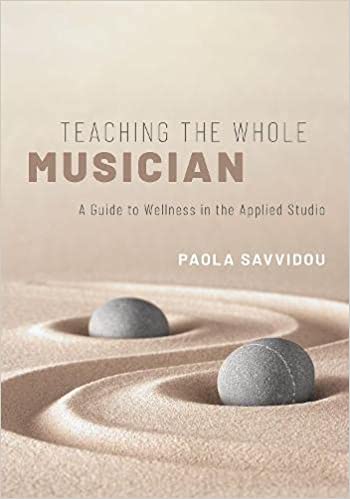 Teaching The Whole Musician: A Guide to Wellness in the Applied Studio. Paola Savvidou. New York: Oxford University Press, 2021. 280 pp. 22 diagrams. ISBN 9780190868796. $99.00.
Teaching The Whole Musician: A Guide to Wellness in the Applied Studio. Paola Savvidou. New York: Oxford University Press, 2021. 280 pp. 22 diagrams. ISBN 9780190868796. $99.00.
In Teaching the Whole Musician, Paola Savvidou provides the reader with a clear idea of the ways in which a typical collegiate music student operates in today's educational system and how the studio teacher can best fulfill their role as educator and mentor. A theme throughout the book is that the studio teacher is crucial in recognizing the problems that students face outside the confines of music and yet not overstepping boundaries by providing medical or psychological advice. Instead, the role of the studio teacher is to help destigmatize physical and mental struggles and encourage the student to put themself first and seek help from a qualified professional.
The first chapter, "Setting the Foundation," defines eight different aspects of wellness and the role of each of these in a collegiate musician's journey to create a "meaningful life" (4). This meaningful life is an ideal that students must accomplish amidst a culture of intense competition, physical strain, and mental fatigue that plagues musicians across the landscape of higher education. A survey is included at the end of the chapter to allow the reader to gauge their wellness. In Chapter Two, “Parent, Teacher, Mentor, or Psychologist?” Savvidou discusses the multifaceted roles that studio teachers play and how they can influence and impact students in a significant way over only a few years of study. She provides examples of how educators can create an environment of inclusivity for all students, cultivate studio identity, and ask the right questions to allow students to improve their wellness while advancing their musical ability.
Chapters Three and Four of the book cover the human body's basic skeletal, muscular, and nervous systems and the common ailments that pertain to each. More severe injuries, such as nerve entrapments and focal dystonia, are also discussed at length. Savvidou details the warning signs of both common and more advanced issues and delineates preventative measures that educators can take to stave off these issues in their studio. Vocal and ear structure ailments are also major discussion points of this section. Savvidou provides an extensive list of ways to help students stay encouraged throughout the process of recovering from injury and methods to help students to grow stronger in ways other than physical practice. Chapter Four, “Stacking the Joints,” is a detailed insight into body alignment for performers and how they can use body mapping to achieve optimal posture and performance. Readers then learn about all the significant parts of the skeletal structure and their proper alignment before doing the same for the entire breathing apparatus. This portion of the book concludes with insight on the pros and cons of sitting versus standing in performance. In Chapter 5, “Protecting the Body,” the reader is provided with methods for saving the body from injury and ways to treat the onset of muscular tension. A questionnaire at the end of the chapter brings awareness to the reader about their habits and how those might coincide with tension and injury. In the following chapter, “Expressive Performance,” the reader learns about movement in performance, as well as the Laban Movement Analysis. This analysis allows the musician to better utilize their body to communicate musical intent during a performance.
The latter chapters of the book focus on mental health in students, mindfulness practices, and the role that sleep and nutrition play in students’ success. Savvidou highlights several factors that stand in the way of a student's success that are not inherently musical, such as living situation, social/cultural issues, and whether they must balance their studies with working significant numbers of hours in order to fund their schooling. Also included is an overview of mental health disorders that educators may find amongst their students, how they are defined and noticeable, and the importance of approaching all students with compassion and understanding. In Chapter Eight, “Turning Inward,” Savvidou delves into how students can spend time in mindfulness practices that benefit their overall state of being while allowing them to be more comfortable with high-pressure performances. These tactics include meditation, breathing techniques, body awareness, and movement-based practices. In the final chapter, “Fueling the Body and Mind,” Savvidou expresses that most students, regardless of their circumstances, will struggle with caring for themselves through proper sleep and nutrition. She uses concrete research to demonstrate how detrimental poor sleep and an unbalanced diet can be. Students, she finds, are more receptive to suggestions regarding sleep and nutrition than they are to advice regarding mental health, so the studio teacher can be essential in providing support and encouragement to aid in this area (215).
A unique feature of Teaching the Whole Musician is the companion website containing several videos explaining the various exercises that Savvidou provides. This website is helpful for readers who learn better visually and who wish to implement the exercises into their practice routines.
Savvidou's research, rooted in highly credible sources (such as The World Health Organization, The National Wellness Institute, The American College Health Association, The National Association of Schools of Music, The American Psychiatric Association, and numerous authors in the fields of research pertinent to student health and wellness), will be of great value to both instructors and students. Teaching the Whole Musician is geared toward new and experienced studio instructors. Savvidou has thoroughly illustrated the many areas where students will experience distress in their education and how mentors can support students with more than just musical insights. This book will also be of great use to current students seeking to better the quality of their practice and of their musical well-being while in school or the professional world after graduating.
